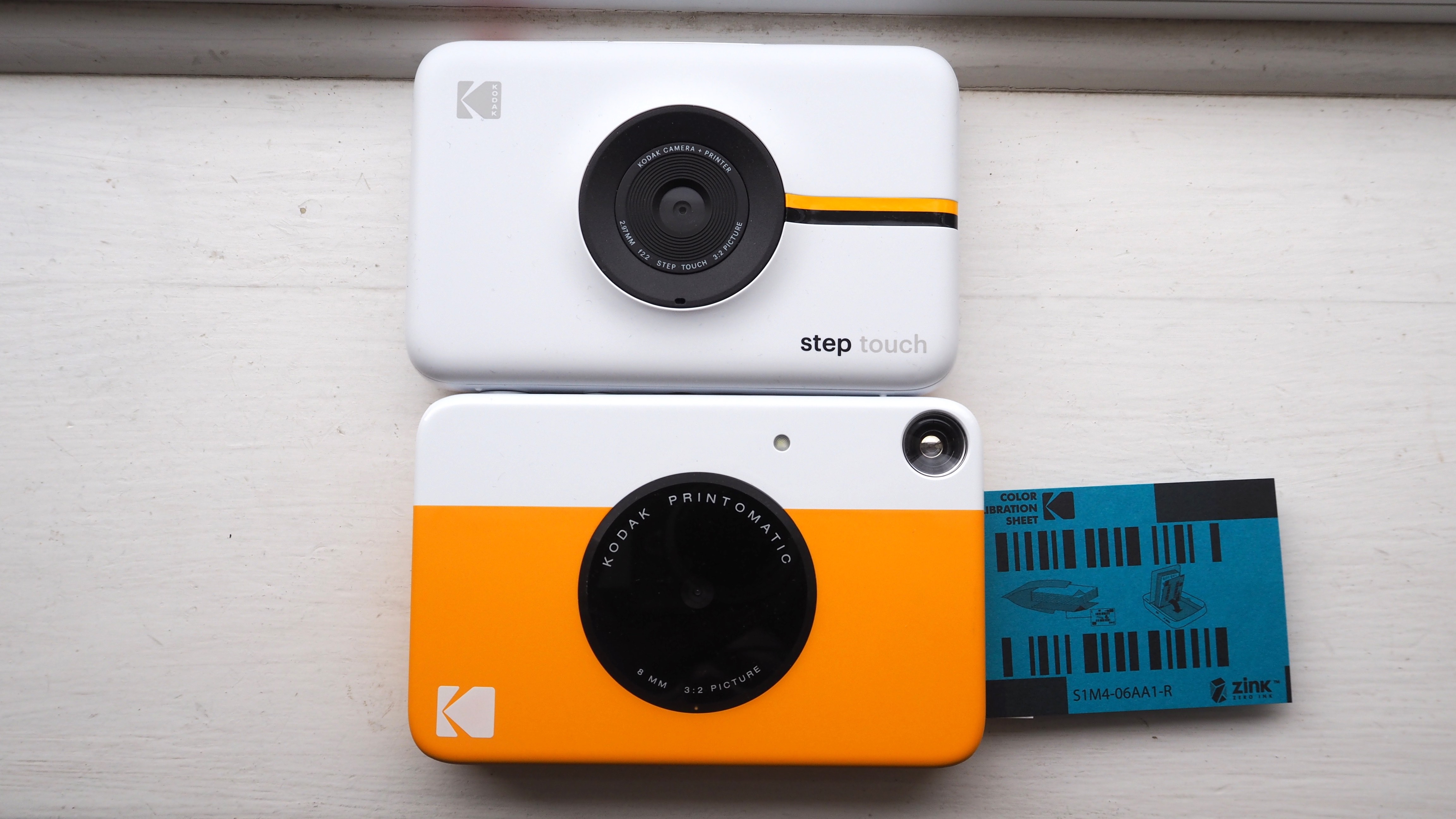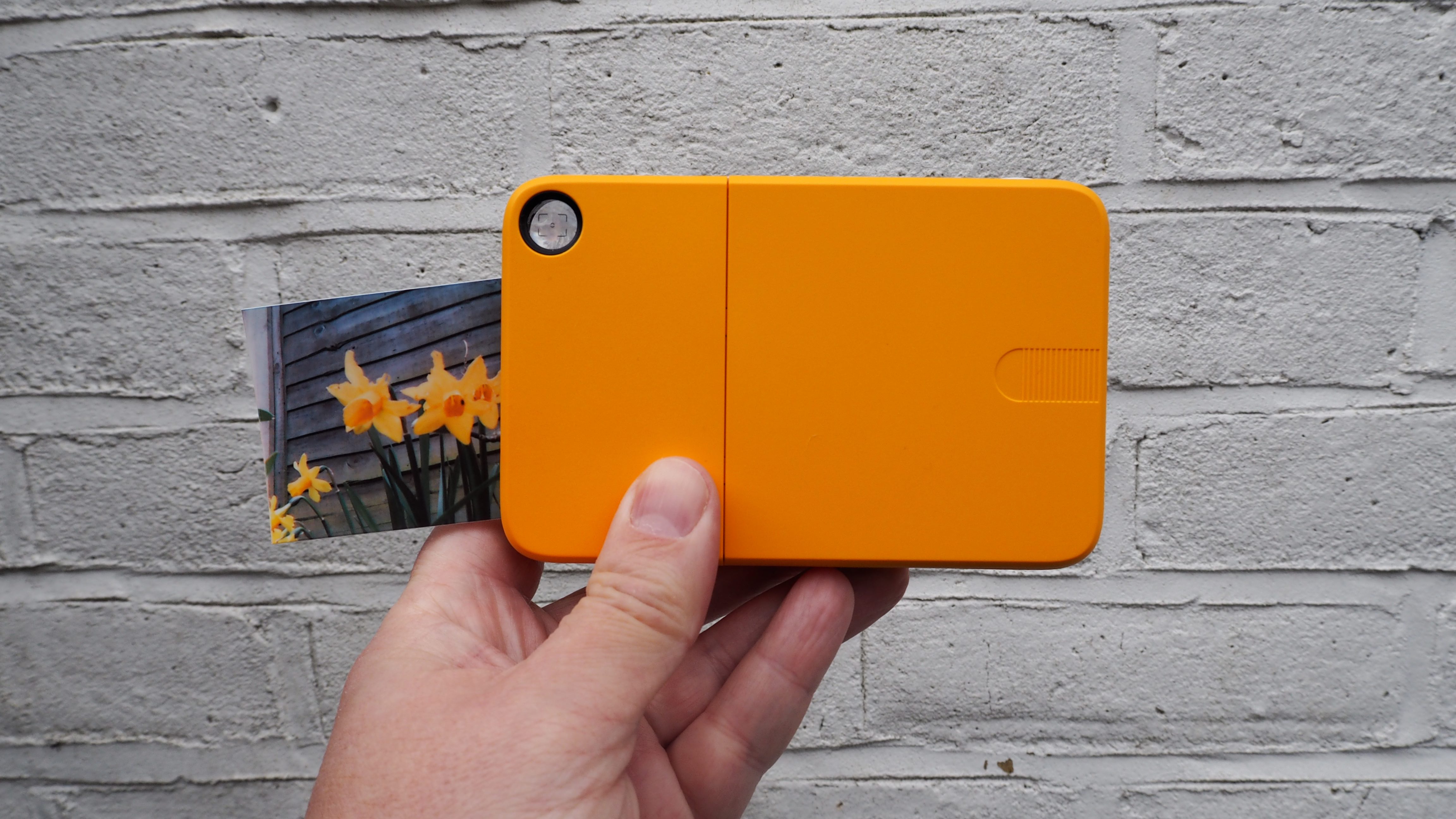
Instant print photography is all about fun and simplicity. While there are devices now available that add rear plate LCD screens and various in-camera editing options to provide users with an experience somewhere between an analog and a digital camera, the Kodak Printomatic Instant Print Digital Camera is pretty much as basic as we can get.
Read more: see our guide for the best digital instant print cameras.
There’s no LCD screen for composing and reviewing our shots, just an old-school optical viewfinder, which is fine. We do however get the option to store captured images if we insert a microSD card at the base of the device. Plus instead of the instant print camera being powered by the usual handful of bulky AAs, instead, there’s a rechargeable lithium battery secreted within the Kodak’s plastic body. A USB port for charging is located next to the card slot.
Like similar entry-level instant print camera options from rivals Canon, Fujifilm, Lomography and Polaroid, the operation on this Kodak is 'auto everything' all the way: automatic focus and automatic printing. And we can’t grumble about that, given that its pocket-friendly size – it’ll rest easy in an adult palm – and pocket-money pricing means that there's plenty of gifting potential here.

Like other Kodak branded instant print cameras the 'Printomatic' employs Zink (zero ink) technology, with small 2x3-inch prints emerging fully finished and dry-to-the-touch. We don’t get the magical experience of a color image gradually appearing from a milky white base as we do with rival Fuji or Lomography cameras, though the internal whirring and clicking of this Kodak before we see our finished credit-card sized print does still an 'experience'.
Whether the novelty for users wears off quickly or if this is an experience they’ll want to repeat time and again depends on the performance and the output, of course. So how does the Kodak Printomatic Instant Print Digital Camera fare in that regard?
Specification
Sensor: 5 megapixels
Sensitivity range: Automatic
Video: No
Lens: 8mm, f2
Monitor: No
Viewfinder: Yes, optical
Battery life: 25 prints per charge
Dimensions: 25x123x79mm
Weight: 199.5g
Key features
There’s no LCD screen provided with this digital camera and printer hybrid. Thus we don’t get the chance to preview or edit photos within the device itself before they’re printed, and so potentially avoid wasting paper on dodgy framing or blurred images.
Though, as with most instant print cameras it’s mostly a case of ‘point and pray’ when shooting here, this Kodak’s old-school optical viewfinder, positioned top left hand corner of the camera back, does provides the handy guide of a small frame overlay. It goes without saying that only what’s within the marked frame that will end up as a finished print.

We’re not great fans of the washed-out colors delivered by Kodak’s zero ink 'Zink' prints when compared with Instax instant prints from rival Fuji. But one possible advantage here is that the Kodak prints all arrive adhesive-backed, so if so desired they can double up as stickers. At the same time, if left as prints they’re less flimsy to the touch than most stickers.
As well as being able to achieve credit card-sized prints of whatever is in front of the wide-angle lens, we further get the ability to insert a microSD card to save our five-megapixel sensor-derived pictures digitally for posterity.
Build & Handling
The cool white and 'Kodak yellow' styling of our particular review sample goes someway to disguising the fact that the Kodak Printomatic Digital Instant Print Camera is the usual boxy design. Alternative camera body colors are also available.
We still have to marvel at the inclusion of a camera and printer within the one device that fits in our palm at only two or three times the thickness of a mobile phone handset, despite looking and feeling rather plastic-y at its pocket money price tag.

However, the decision not to include a USB cable with the camera feels like a cost-cutting exercise too far, as, even though we might in theory already have a compatible lead that works with our smartphones or tablet, said cable is essential for recharging the battery and on-going operation. We borrowed the USB cable that comes supplied with the more expensive Kodak Step Touch Instant Print Camera; otherwise, we’d just have been left with a rather colorful plastic doorstop.
Loading the starter pack of a mere five sheets into the camera is simple enough. It involves sliding open the back cover and dropping the sheets into the recess provided, with the blue calibration sheet at the bottom, before pushing the rear plate back into place. This is a simple enough process that shouldn’t tax either the kids or grandma and granddad.
Packs of 50 or 100 sheets are readily available and work out cheaper per print in the long run. Printing is a fully automatic process that commences a second or two after the shutter release button has been squeezed. This ‘gap’ sometimes prompts us to fire off an extra shot and waste a sheet. Incidentally, the battery in this particular model is claimed to last 25 prints before it needs recharging, compared to 40 prints for the more expensive Kodak Step Touch alternative.
There’s no carry case or lens protector supplied with the camera – it arrives with a peel-off adhesive sheet protecting the lens out of the box – although third-party manufacturers do offer optional camera cases that fit this model.
Performance
It’s point-and-shoot all the way as expected with the auto-focus Kodak Printomatic Instant Print Digital Camera and its wide-angle f/2 aperture lens. If we’ve one grumble it’s that the power on/off and shutter release buttons have both been placed next to each other on the far right of the top plate. This means that with our eye occupied by whatever we can see through the optical viewfinder, it’s easy to hit ‘power off’ when we meant to hit shoot.
The shutter release also seems rather sensitive generally, and we found ourselves accidentally taking pictures when we didn’t mean to. Being able to review the pictures before they print – rather than printing being an automatic process – would have been advantageous here.

Of course, our minor grievances come with the caveat that the focus here is on fun rather than color and subject fidelity. Thus many will be prepared to overlook the fact that the Zink prints more closely resemble color photocopies than true photographic prints we’d get back from the lab or local retailer.
Generally, the look is very flat and two-dimensional. Still, younger members of the family thrilled by the theatrics of a print emerging from the device shortly after they’ve clicked the shutter release button will doubtless be far less critical!

Verdict
The Kodak Printomatic Digital Instant Print Camera delivers good, clean, simple pleasure but loses a star for bizarrely not including the essential element of the USB lead it requires to power it up. We’re also deducting a star for the crude appearance of the prints automatically made on Zink photo paper. Not that the younger members of the family who want to peel off the back and turn them into stickers will mind we’re falling far short of gallery quality here.
And, if your budget will stretch to it, we’d recommend the more advanced alternative in the identically sized Kodak Step Touch. While not perfect, the pricier model has the advantage of a back plate LCD for reviewing shots before printing them – and so avoiding waste. It also thankfully arrives supplied with a USB lead, so no need to hunt around at home for one that fits.
You might also like...
If you are tempted to buy this instant print camera be aware its manufacturer also offers the similar-in-appearance Kodak Step – which comes with a pop-up optical viewfinder – as well as the Kodak Step Touch which adds a very useful, if hard to-view in sunlight, touch screen LCD, and pop up flash.







